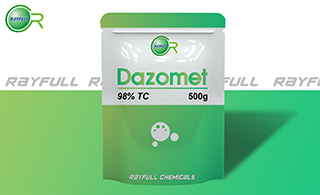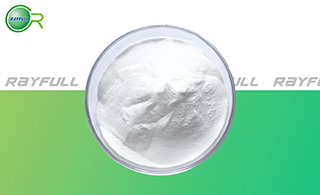DAZOMET
  ГЮВЎ ГЮВЎ
Introduction: Broad spectrum soil fumigant. It will be decomposed as toxic Methyl isothiocyanate, formaldehyde and hydrogen sulfide in the moist soil, and spread into the soil particles quickly. Used to control Nematode, pathogenic bacteria, underground insect and germinating weed seeds in greenhouse, field crops, seedbed, bonsai soil, seed growing field, continuous cropping field.
Common name: Dazomet
Another name: Basamid, Thiazone, Tiazon, Mylone, Thiazon, DMTT, Carbothialdin, Nefusan, Prezervit, Crag nemacide, Basamid-Puder, Mico-fume, Dimethylformocarbothialdine, Basamid G, Basamid P, Basamide, Mylon, Dazoberg, Micofume
Chemical name: 3,5-dimethyl-1,3,5-thiadiazinane-2-thione
Empirical formula: C5H10N2S2
Structural formula:

Mol. Weight: 162.3 g/mol
CAS No.: 533-74-4
Specifications
Leading Dazomet supplier
Dazomet 98% TC
Packing:
BULK PACKING
Solid: 25kg/Bag, 25kg/Drum, 50kg/Drum etc.
SMALL PACKING
Solid: 1kg/Alu bag, 500g/Alu bag, 200g/Alu bag, 100g/Alu bag, 50g/Alu bag, 15g/Alu bag etc.
Customerized packing label
Dazomet FAO standard
Professional registration
HAZARDS IDENTIFICATION
Hazard statement(s)
H302: Harmful if swallowed.
H319: Causes serious eye irritation.
H400: Very toxic to aquatic life.
H410: Very toxic to aquatic life with long lasting effects.
Precautionary statement(s)
P264: Wash ... thoroughly after handling.
P270: Do not eat, drink or smoke when using this product.
P273: Avoid release to the environment.
P280: Wear protective gloves/ eye protection/ face protection.
P301+P312: IF SWALLOWED: call a POISON CENTER/doctor/... IF you feel unwell.
P305+P351+P338: IF IN EYES: Rinse cautiously with water for several minutes. Remove contact lenses if present and easy to do - continue rinsing.
P330: Rinse mouth.
P337+P313: IF eye irritation persists: Get medical advice/attention.
P391: Collect spillage.
P501: Dispose of contents/container to ...
Supplemental Hazard Statements: none
MAMMALIAN TOXICOLOGY
Acute toxicity: 1) Acute oral LD50 for rat: 415 a.i.mg/kg. 2) Acute dermal LD50 for rat: >1000 a.i.mg/kg. 3) Inhalation LC50 (4 h) for rat: >7.3 a.i. mg/L. 4) Non-irritating to skin (rabbits). 5) Non-irritating to eyes (rabbits). 6) Not a sensitizer (guinea pig). NOEL in rats is 20 mg/kg diet.
ADI: 0.01 mg/kg b.w./day[Rat, SF=100]
Classification:
Toxicity class WHO (a.i.): II (Moderately hazardous)
US EPA Classification (formulation): III (Caution - Slightly toxic)
EC Risk Classification: Xn - Harmful: R22; Xi - Irritant: R36; N - Dangerous for the environment: R50, R53
ECOTOXICOLOGY
Effect on birds: moderate toxicity to birds, acute LD50 for Bobwhites quail is >415 a.i.mg/kg. Effect on fish: moderate toxicity to fish, acute 96 hour LC50 for Bluegill sunfish is 0.3 a.i.mg/L. Effect on aquatic invertebrates: moderate toxicity to aquatic invertebrates, acute 48 hour EC50 for Daphnia magna is 19.0 a.i.mg/L. Effect on algae: moderate toxicity to algae, acute 72 hour EC50 is 0.275 a.i.mg/L. Effect on honeybees: moderate toxicity to honeybees, contact acute 48 hour LD50 is >24 a.i.ҰМg/bee. Effect on earthworms: high toxicity to earthworms, acute 14 day LC50 is 6.5 a.i.mg/kg.
ENVIRONMENTAL FATE
Dazomet's production and use as a rubber accelerator and as a vulcanizing agent may result in its release to the environment through various waste streams. It's use as a fungicide will result in its direct release to the environment. If released to air, a vapor pressure of 1.72ЎБ10-5 mm Hg at 25 deg C indicates Dazomet will exist in both the vapor and particulate phases in the ambient atmosphere. Vapor-phase Dazomet will be degraded in the atmosphere by reaction with photochemically-produced hydroxyl radicals; the half-life for this reaction in air is estimated to be 1 hour. Particulate-phase Dazomet will be removed from the atmosphere by wet and dry deposition. Photolysis half lives of 20 days and 4.3 hours have been calculated from measured rate constants for Dazomet in soil and water, respectively. If released to soil, Dazomet is expected to have low mobility based upon a Koc of 676. Volatilization from moist soil surfaces is not expected to be an important fate process based upon a Henry's Law constant of 3.26ЎБ10-7 atm-cu m/mole. Dazomet is not expected to volatilize from dry soil surfaces based upon its vapor pressure. Half-lives for Dazomet measured during soil field studies range from 1 day to 15 weeks. Dazomet is expected to undergo biodegradation in soil since this substance has been reported to degrade more rapidly in unsterilized soil than in sterilized soil. If released into water, Dazomet is expected to adsorb to suspended solids and sediment based upon the measured Koc. Biodegradation is expected to be slow in water based on only 2.8% and 30% degradation after 20 days during screening tests that used sewage sludge innocula. Volatilization from water surfaces is not expected to be an important fate process based upon this compound's Henry's Law constant. Measured BCF values of 1.1-4.4 suggest bioconcentration in aquatic organisms is low. The hydrolysis half-lives measured for Dazomet at pH 5, pH 7 and pH 9 were 68.5 days, 3.5 days, and 6.9 hours, respectively. Occupational exposure to Dazomet may occur through inhalation and dermal contact with this compound at workplaces where Dazomet is produced or used. (SRC)
Usage: Originally prepared by M. DelЁҰpine (Bull. Soc. Chim. Fr., 1897, 15, 891), later introduced as a soil fumigant. Manufacturers: BASF
Application: Soil sterilant, applied prior to planting out crops, at 200-600 kg/ha. Controls soil fungi (Fusarium, Pythium, Rhizoctonia, Sclerotinia and Verticillium spp. and Colletotrichum coccodes), nematodes, germinating weed seeds, bacteria and soil insects. Also used as a slimicide in pulp and paper manufacture, and as a preservative in adhesives and glues. Phytotoxicity Highly phytotoxic to all green plants. Treated soils should not be planted until shown to be free of dazomet and its degradation products.
| 






